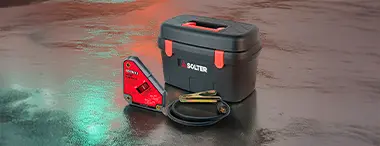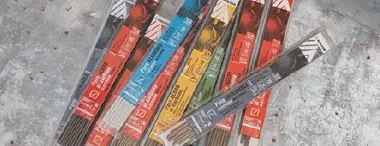MIG/MAG Gas Shielded Arc Welding
Process Description
Gas-shielded arc welding is a welding process in which the necessary heat is generated by an arc established between a consumable electrode and the metal to be welded.
A solid, bare wire, fed continuously and automatically, serves as the electrode. This wire becomes the deposited metal as it melts.
The electrode, arc, molten metal, and adjacent areas of the base metal are protected from atmospheric contamination by a flow of gas supplied through the nozzle of the torch, concentrically around the wire or electrode.
Applications
The MIG/MAG process can be used for welding all materials (carbon steels, stainless steels, aluminum, etc.).
The use of a continuous electrode increases productivity by eliminating the need to change electrodes and allows for a high deposition rate. Welding speeds much higher than those with coated electrodes can be achieved.
It is an easy-to-apply process that allows welding in any position. Long weld beads can also be made without the need for stops or restarts. Additionally, no slag removal is necessary, as no slag is produced.
On the downside, the equipment is more expensive, larger in size, and requires gas installation, which limits its use to indoor industrial environments.
Welding Equipment
The basic welding equipment for MIG/MAG consists of:
- Power Source
- Wire Feeding Unit
- MIG/MAG Torch
- Shielding gas cylinder (depending on material)
- Ground clamp
Power Source
The power source must be capable of operating at high intensities and supplying a stable direct current to continuously melt the wire.
It may require single-phase (1ph) or three-phase (3ph) power supply, depending on its power and consumption.
Wire Feeding System
The wire feeding unit is the device that allows the wire to pass through the contact tube of the torch to melt in the arc. MIG/MAG equipment includes a system to vary the wire feed speed, as well as a solenoid valve for gas flow control.
A motor transmits power to the drive rollers, which push the wire from the spool to the contact tip of the torch. The rollers are usually one flat and the other beveled. The bevel can be V-shaped for hard materials like steel and stainless steel, or U-shaped for soft materials like aluminum.
Torch
Continuous wire welding guns must allow smooth wire feeding at a predetermined speed. Additionally, they must conduct the welding current to the wire and properly direct the shielding gas.
Ground Clamp
Proper connection of the ground clamp is essential. The cable’s placement is also critical: a poorly secured cable will not provide reliable electrical contact, which can cause overheating, circuit interruption, and loss of the arc.
The contact area must be clean and free of paint, varnish, oils, or other substances that could hinder electrical contact.
Welding Parameters
Filler Materials
The wire acts as the electrode and simultaneously provides the filler material needed to create the joint.
The most commonly used wires have diameters of 0.6, 0.8, 1.0, and 1.2 mm, and are supplied on coils that are placed directly in the feeding systems. To ensure a smooth and consistent feed, the wire must be properly wound in flat layers and should not be taut.
Steel wires often have a copper coating, which improves electrical contact, reduces corrosion, and decreases friction in the feeding systems and torch.
The filler material should have a chemical composition as similar as possible to the base metal.
If the wire diameter is changed, the guide tube, contact tip, and rollers must also be adjusted to the new diameter.
Gasless Wire Welding
There is a type of wire called "flux-cored wire" or "tubular wire" that allows welding without the need for shielding gas. It is ideal for outdoor work or conditions with drafts.
To use this type of wire, the equipment must allow polarity reversal:
Torch connected to the negative pole (−) and ground clamp to the positive pole (+).
Wire Speed
The wire speed must be adjusted according to the welding current to ensure that the wire melts evenly.
If the welding power is changed (due to a change in material or wire diameter), the wire speed must also be adjusted accordingly:
- Lower current = lower speed
- Higher current = higher speed
Welding current
This parameter is selected based on the type of material, its thickness, and the wire diameter. The current directly influences the wire speed.
Shielding Gases
The gas protects the weld pool from atmospheric contamination. The choice depends on:
- Type of material to be welded
- Modo de transferencia metálica deseada
- Penetration
- Bead shape
- Welding speed
- Gas cost
Most common gases:
| Material | Shielding Gas |
|---|---|
| Steel | Argon 85% + CO2 15% 5% + CO2 15% (Corgon) |
| Stainless Steel | Argon 98% + CO2 2% (Mison) |
| Aluminum | Argon 100% |
Recommended flow rate:
As a general rule, it is calculated as 10 times the wire diameter.
Example: 0.8 mm wire → 0.8 × 10 = 8 L/min
Join our newsletter!
Be the first to receive our updates and brochures! We promise not to flood your inbox!





